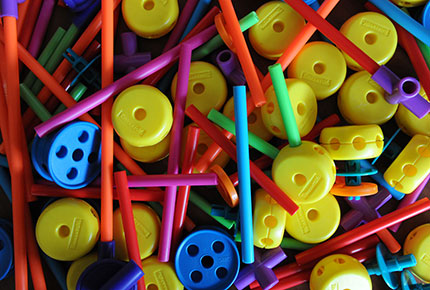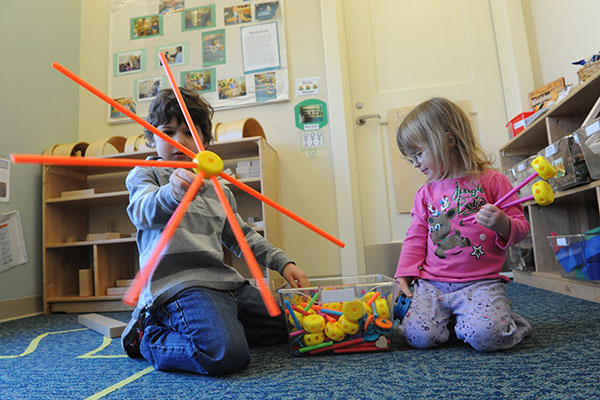2011 TIMPANI Toy Study Results
(This video has captions. You can turn them on by clicking the CC icon at the bottom of the video.)
Download a printable transcript.
Narrator: The Center for Early Childhood Education at Eastern Connecticut State University is pleased to announce the results of it 2010 TIMPANI Toy Study. Toys that inspire mind-full play, and nurture imagination. We know that young children learn critical skills and knowledge through their play engaging in make believe, creating something new, and playing with friends, helps children to acquire the social and intellectual skills needed for success in school and adulthood. While there is much research on children’s play, few studies have looked at how children interact with toys in their play. To address this research gap, the center conducts the annual TIMPANI Toy Study, under direction of Dr. Jeffrey Trawick-Smith. The study looked at how young children in natural settings, played with a variety of toys.
Dr. Jeffrey Trawick-Smith: Toys are really a fundamental part of a preschool curriculum. First off, a lot of a preschool day is still devoted to play. Where children engage in playful activities with their peers. One of the things that research shows is that a large percentage of play involves toys. So what the TIMPANI project is identifying the toys that contribute to specific areas of development. We tried to capture groups of children, naturally interacting and playing together with these toys. Once we have video captured for each of the toys, we use a coding instrument. We score these toys across three specific areas. We would look at what kinds of intellectual activities children would engage in as they’re playing with them. We would look at the degree to which they express themselves in imaginative or creative ways. The last thing is just looking at the amount of social interaction and the language children use as they’re playing. If we can identify some of the characteristics of toys that score very high, in our study in these different areas, we can use that information to guide teachers with making choices in their classroom, to help parents make selections at home.
Narrator: The study provides on going opportunities for Eastern students to engage in meaningful research, helping to meet the university’s mission to provide experiential learning opportunities for students.
Kelly Zimmermann (Student Researcher): My role in the study was really unique. I was able to videotape the students playing with the toy, so I got a firsthand look at how all of the toys were interacted with. I was actually able to use a rubric that was developed and go in and score the toys. I think the most valuable part of the study, for me personally, is that I will be able to bring the knowledge that I learned about children’s use of toys into my own classroom setting when I am a teacher. I think it’s really important to see how some toys encourage children to use their imagination. From taking such a simple object and creating something unusual.
Narrator: Of the toys studied in 2011, Hasbro’s Tinker Toys earned the highest rating. This year’s study looked at a colorful plastic version of Tinker Toys.
Kelly Zimmermann (Student Researcher): The language development that I observed was very expansive. Children used words such as “appear” “bulldozer,” they were making lollipops and licking them. It was a constant stimulation of imagination.
Girl: I am a robot, take me to your leader.
There were two hundred pieces in the container, so it allowed all children to have freedom to use whatever pieces they wanted to use to construct whatever images they were creating in their head.
Boy: This is a steering wheel. Drive. Drive this way.
Girl: How do you fit three in here?
Patricia Gardener (Preschool Teacher): One of the things that I liked about the Tinker Toys was the opportunity for the children to use them in many different areas. Some of the children were laying it out flat and using the surface as part of their play. They were using it to spell out letters and make different shapes as different instruments.
Girl: Abracadabra!
I noticed a lot of dramatic play.
Boy: It looks like a helicopter thing!
Ashlee Parks (Preschool Teacher): One thing that I noticed a lot that I really enjoy about the Tinker Toys was that children were able to play with them individually and also cooperatively. So they had used the circles and lots of rods to make helicopters which lead to some pretend play because they stood up and starting walking around to pretend to move the helicopter. So it was a role playing type of experience and not just a constructing experience.
Patricia Gardener (Preschool Teacher): The pieces are not similar, they’re very different from each other. You have this long pipe, then you have this ring like thing, then you have this yellow disk. I guess maybe that fosters creativity and asks the children to look at different ways to put all these pieces.
Boy: This is a telescope!
Dr. Jeffrey Trawick-Smith: I gotta say, that I was initially surprised that Tinker Toys, of all the toys that we looked at,scored highest across all areas that we looked at. But then I thought about it; it really confirmed what we’ve been finding, which is that really basic and open ended toys tend to really be beneficial to children in their play and learning. Tinker Toys have been around for a hundred years or more, and there’s a reason for that. They’ve lasted as long as they have because both parents and teachers and children have sensed these have some special qualities that allow children to express themselves, to learn about things, to solve problems, and to interact with their peers.
Narrator: The Center for Early Childhood Education is now accepting nominations for the 2012 TIMPANI Toy Study. To learn more or to nominate a toy, please visit our website at www.easternct.edu/cece




